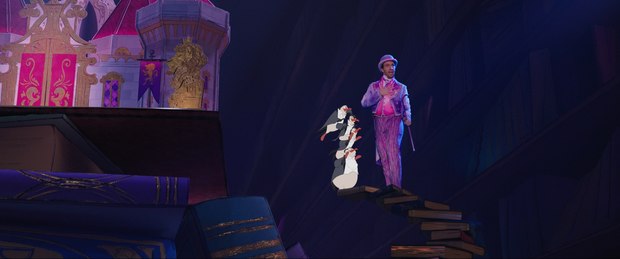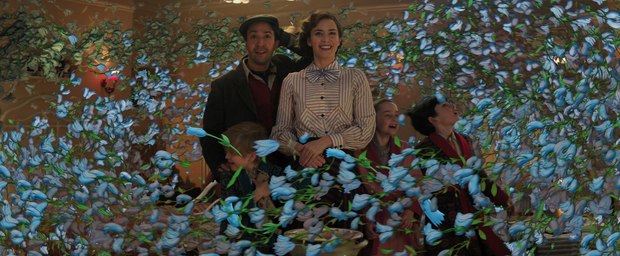Annie-nominated character designer James Woods details the development of a host of characters for the animated sequences in the Disney sequel, including a new look for the iconic four penguins.
Opening this weekend, Mary Poppins Returns is positioned as a sequel to the classic 1964 Disney feature, set in 1930s Depression-era London, two decades after the events of the original film. Based on PL Travers’ series of eight Mary Poppins books, the film sees the magical nanny return to help the Banks family rediscover the magic after tragedy strikes and the bank is threatening to foreclose on the family home.
Directed by Rob Marshall, the film stars Emily Blunt in the titular role, along with her friend Jack, played by Lin-Manuel Miranda. Ben Whishaw plays Michael Banks and Emily Mortimer plays Jane Banks.
Like the original, Mary Poppins Returns combines live-action and traditional hand-drawn animation, including roughly 17 minutes of animation. James Woods served as lead character designer of the animated sequence and his work has earned the young animator an Annie Award nomination for outstanding character design in an animated feature production.
Woods explained that his role was coming up with the looks for a host of characters throughout the animated sequence, including Shamus the coachman, Clyde the horse, Frye the weasel and Gooding the badger as well as a new look for the four penguins. “Those were my main focus, but I also got to design all of the animals that populated that world,” he says. “It was my role to basically discover the shape language and design for them and then, hopefully, follow that through to what we see on the final screen in the end.”
The original film segues from live-action to a combination of live-action and animation when the characters dive into the chalk drawings of chimney sweep Bert (played by Dick Van Dyke), temporarily leaving the real world behind. In Mary Poppins Returns, the portal to the animated world is a Royal Doulton bowl that takes them back in time to the Royal Doulton Music House.
Brought on about five months before the animation process started, Woods collaborated with production designer and art director Jeff Turley and animation sequence supervisor Jim Capobianco, as well as environment designers Sunmin Inn and Emil Mitev to “find the rules and the looks for this world that was going to be set inside a ceramic bowl,” as he explains.
Initially, Woods worked closely with Turley to create some of the key story moments, “just experimenting with how much of that inky, watercolor wash we would show. And I would then come in with some character ideas to then put on top of that and collaborate back-and-forth. It was very blue sky at the beginning, so initially we were just to discovering the look of the movie, and then from there, we got to be more production-oriented and really focused on making characters that would be specifically ready to animate for a team of people,” he recounts.
These designs were then passed off to lead animator James Baxter. “There was a lot of back-and-forth between me and him in the studio, with me doing the initial design, handing off to him to then pack it and use his animation knowledge in turn to meet a classical Disney hand-drawn style,” Woods details. “And then these packets were eventually handed off to the animation studio who produced the animated portion. But we were very active a couple months into the actual animation period, as well.”
Woods said that, from the outset, they wanted to honor the legacy of the original, and maintain continuity with it, so a lot of the look is based on a 1960s style of Disney Animation, which meant “a lot of cel, inky lines,” he notes.
“We were also looking at illustrations from the late 1800s, which is really when the sequence takes place when they travel back in time inside the bowl. We were trying to reference some of the art styles and shapes of silhouettes from the costuming,” he adds, “And then we made a big mood board, kind of melting pot of all those influences to then also try and bring something that is modern for a 2018 audience, that really honors what the original movie had going on.”
In addition to revisiting some of the animal characters of the original, like the four penguins, the animated sequence called for almost two dozen new animal characters. When it came to designing some of those animals, Woods explained that while Google is every designer’s best friend, “there’s nothing better than being able to study in person.”
That led him to the L.A. Zoo to sketch animals and observe how they behaved and how they moved about their enclosures. “I was trying to think about how those animals would interact with clothing, how fur would fill out inside of the restricted materials, and how that would aid the shape language that was going on… [while] looking at all kind of costume books which outline the shapes and silhouettes we would see at that period in time.” he says.
Setting a color palette was also an early concern, especially in the transition from the Royal Doulton bowl to the music hall. “We wanted that to be pastel-y and summer-y and light and playful. And then, inside the Music Hall, which is set at night time, it had to be more theatrical,” Woods recalls. “Initially, with the production designer, we had an idea of the tone and palette that would be set there. A lot of it was intuitively created in those moments, but we knew that we wanted to tell a story from the outside of the bowl into the inside and show that drama and play up to the musical number that goes on.”
Woods noted that there were often instances where one of his design drawings would end up being a key frame for the animators to work from. “A design that I would have cut out with a pose can end up being translated, pretty much directly into a scene,” he explains. “I felt very proud and lucky in those instances where I got to see my drawings on the screen.”
However, those moments weren’t always just a happy accident. “I looked at the storyboards that our story team had put together and tried to design a lot of those story moments that the characters would be specifically posed with the intent of what they would be playing out in the scene. There were instances where I was working from the boards and thinking, ‘okay, this character had to deliver this line at this moment’ and would treat that almost as a hero pose that speaks to that specific moment in the animatic. Also when designing, we’d want to think about a line or a specific role or part that’s in that scene that a character had to fulfill and draw specifically to that,” Woods says.
“Not only does that straighten the design of the character, but also, the purpose of them is that the animator or director can look at that character and immediately put them into context in that scene and see the emotions or what their purpose is,” he elaborates. “That’s really important for me in design, so that I can see that it’s not just a mannequin of a character, but they’re actually acting and reacting in the moment -- doing what’s necessary for them.”
According to Woods, the biggest challenge was ensuring that his initial sketches would be workable for a team of animators further down the pipeline. “It’s very easy for me to make a drawing or design that feels comfortable for me, but I have to [keep in mind] that that it has to be passed off to these different animators, so creating a shape language and style guide that was, hopefully, easy to translate for the animators to see that style throughline and take that from the early beginnings of a character, and tie it down to the characters that we end up seeing onscreen was key,” he says. “I guess the biggest challenge for me was understanding that these drawings really serve a bigger purpose than just being a look for me and the director. It’s being the guideline for the rest of the animation team. It has to take on a life of its own.”
Woods said his role on the film wrapped up in April 2017, and he’s amazed to finally see the end result. “It’s been such a long time and it’s evolved in such a way I wouldn’t have imagined and I’m so proud of it,” he concludes. “I realize how lucky I am to have been a part of a traditionally animated production so early in my career. We aren’t given these kinds of opportunities often, so I don’t take for granted for a second how great this production is and how once-in-a-lifetime it is, as well.”
Scott Lehane is a Toronto-based journalist who has covered the film and TV industry for 30 years. He recently launched VRNation.tv -- an online community for VR enthusiasts.











